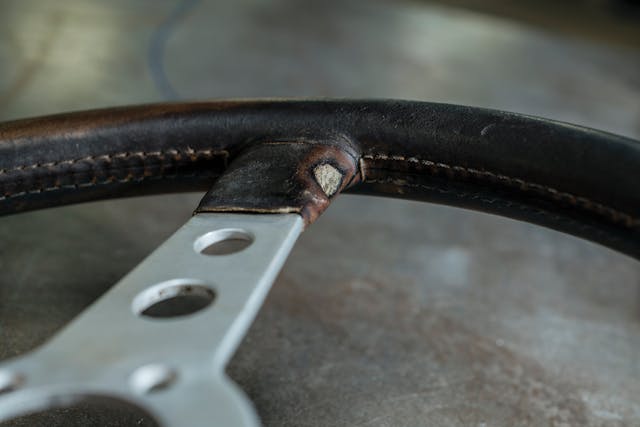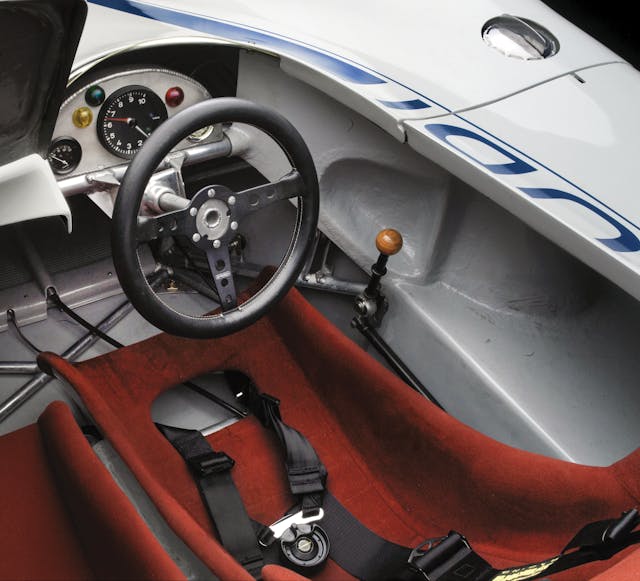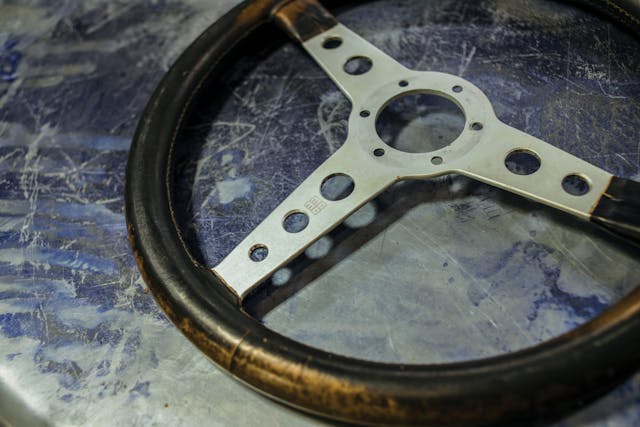Perfect Circle: Momo’s Prototipo steering wheel isn’t flashy, and that’s the appeal
There are Instagram accounts and fan sites; eBay sellers holding the rarest beasts in the field; dedicated obsessives boasting hundreds of examples in their collections and displaying these pieces in their homes like hunters mounting their hard-won, taxidermied prizes.
Welcome to the passion of the vintage steering wheel, and to one of the most storied names in car culture—the vintage Momo, the face that launched a thousand apexes, the timeless Italian circle with the deliciously tidy name.
Born into a wealthy Milanese family, Gianpiero Moretti found racing while studying political science at the University of Pavia. If you believe the lore, at the age of 24, he designed his first wheel in a garage in 1964—the leather-covered rim was thicker and smaller than the industry average, for a finer sense of control. When the legendarily skilled John Surtees won the Formula 1 World Championship for Ferrari that year, he used a new Moretti wheel. Moretti said the helm was ordered personally by Enzo Ferrari; other accounts hold it had been specified by Surtees himself, and that il Commendatore needed to be convinced of the benefits, attached as he was to a traditional wooden rim.
Whatever the truth, Moretti’s work made a dent in the culture. The accessories company he founded in 1966 was called Momo, for Moretti Monza, hat-tipping the Italian track. In the early years, the firm sold not just wheels but racing suits and other gear, reflecting Moretti’s romantic vision—and embodiment—of a pro’s track life and neon personality. (No less than Mario Andretti once called Moretti a “flamboyant, likable guy.”) Ferraris soon came with Momo wheels, and in the late 1960s, when the Porsche 917 went to Le Mans with a factory-installed Momo Prototipo, you could buy a virtually identical wheel for your road-going 911. In the years that followed, Momo parts landed wins from Sebring to Salisbury, and the company became an OEM supplier to manufacturers as varied as Mazda and Rolls-Royce.

Steering-wheel collectors appreciate the racing aura, but also the uniquely Italian sense of myth—that shrugging approach to history, where record-keeping is often seen as nuisance and facts rarely compass the bolder, brighter romance. With early and uncommon Momos often trading hands at four-figure cost, the wheels can seem like attainable relics of a simpler time, where the hand-worn leather provides obvious evidence of the connection between body and machine. [Smith’s “Weissrat” BMW 2002 features a vintage Momo, whereas editor Larry Webster’s 911 has a modern reproduction -Ed.]
Mads van Appeldoorn runs the Momo fan site patipatina.com. He has owned around 500 vintage wheels, though his collection currently holds only 50, including an early, 380-millimeter Monte Carlo made by Moretti himself, before creation of the Momo label. Prototipos seem to be “the one to have,” van Appeldoorn explains, not least due to the Porsche connection and because a version of the wheel is still made today. But the prime appeal, he claims, is in the aesthetic perfection that Moretti laid out.
“The ratio of spokes to circumference, the size of the spoke holes [if there were any], the way the leather has been treated and stretched around the rim—it just felt right, balanced. You might say a Nardi”—Italy’s other wheelmaking titan—“is not that different, but for me, it starts with the hub pattern: first bolt at 12 o’clock, straight in the direction of driving. It feels harmonious and calm.”

Naturally, values vary. More common vintage Momos in rough shape can be had for as little as $20. Sought-after rarities from the 1960s, like the Sebring or Monte Carlo, can take years to find and are priced accordingly. Parts can also be pricey. Vintage Momo-made marque horn buttons (logos shifted over time) and vintage solid hubs (new ones are collapsible) often fetch hundreds of dollars, which doesn’t sound like a lot until you notice that the hubs are indifferently cast pot metal and the horn buttons are made of cheap-looking plastic the diameter of the top of a soda can.
Chalk it up to Italian charm—and part of the fun. There is no singular great source for vintage-Momo information, Appeldoorn says, not even the company itself; manufacturing changes were never well-documented, even for high-profile signature wheels named for racers like Lauda and Andretti. Or take the Prototipo: It began life as a flat-spoke wheel in mostly large diameters, 370 and 380 millimeters. Spokes were later dished for strength, the leather and stitching evolved, and engravings and fonts were altered and moved around. Still, even for the brand’s most storied offerings, nobody logged those alterations in company books. This is, interestingly, where an enthusiast’s typical obsession with minutia blurs against the unprovable. If you want to know, Appeldoorn says, you have to dig on your own.
Moretti sold his company to an American firm, Breed Technologies, in 1996. Momo remains based in Italy but is now owned by the MW Company, with a design office in Los Angeles. MW’s creative director, Howie Idelson, a co-founder of Porsche gathering Luftgekühlt, says the brand is influenced heavily by American desires, “because aftermarket equipment is so restrictive in Europe.”

And what about the idea of a road-going tool, someone’s hard work, displayed as dust-gathering “art” on a wall?
“I love it,” Idelson says. “I think it’s a tribute to how strong the brand is, the history and story. And it ultimately comes down to this recently renewed passion for driving old cars—that steering wheel is a connection, the experience coming into your hands and body.”
Four years ago, Momo launched its Heritage line, a reimagining of vintage models like the Prototipo and the Grand Prix. These new wheels retail for around $300 and offer the perfume of vintage aesthetics—primarily distressed leather and classic logos. They aren’t literal reissues, but they’re a nice nod to the obsessives, and the feel is right. Which matters most of all, Idelson says.
“I think ‘simple’ is a good word here. The Prototipo is a great example. It’s not invasive, and the spoke concavity—people seem to like the position it puts them in. It looks at home in any car of the era.”
“My first one came in a vintage Porsche 911, 20 years ago,” van Appeldoorn says. “A beat-up, sunburned Prototipo, cracked leather, a bit greasy, worn aluminum, lots of patina. But from that moment, I was caught by the idea of vintage steering wheels in vintage cars. The only palpable connection between the driver and the road.”
This feature originally ran in the Hagerty print magazine RADIUS, a perk of one of our exclusive member programs.
Check out the Hagerty Media homepage so you don’t miss a single story, or better yet, bookmark it.



I gave into the allure with my 911sc and fitted a Prototipo 350. A few years ago I picked up another in 370 diameter.
Both unfortunately feel extremely flexible and I wonder if maybe a vintage one was made differently.
They don’t make ’em like they use to is what they say, right?